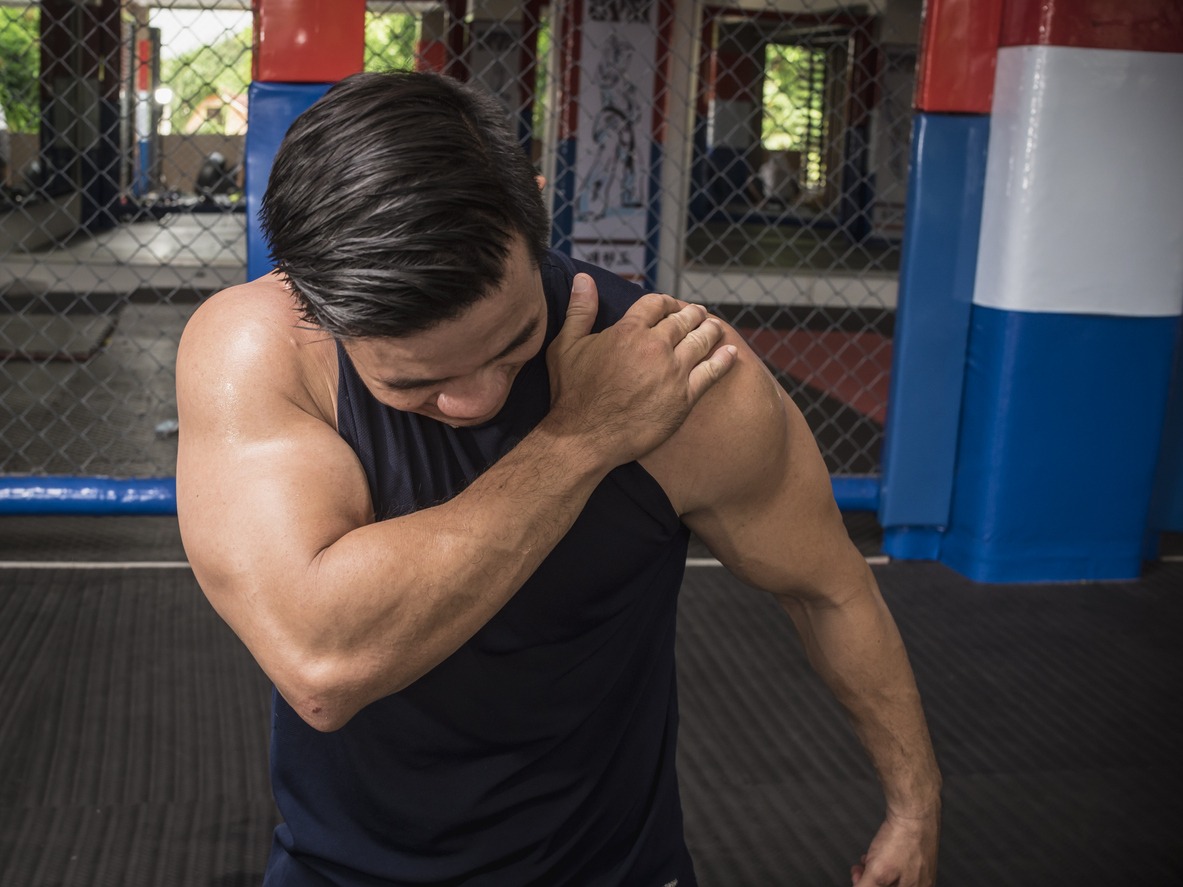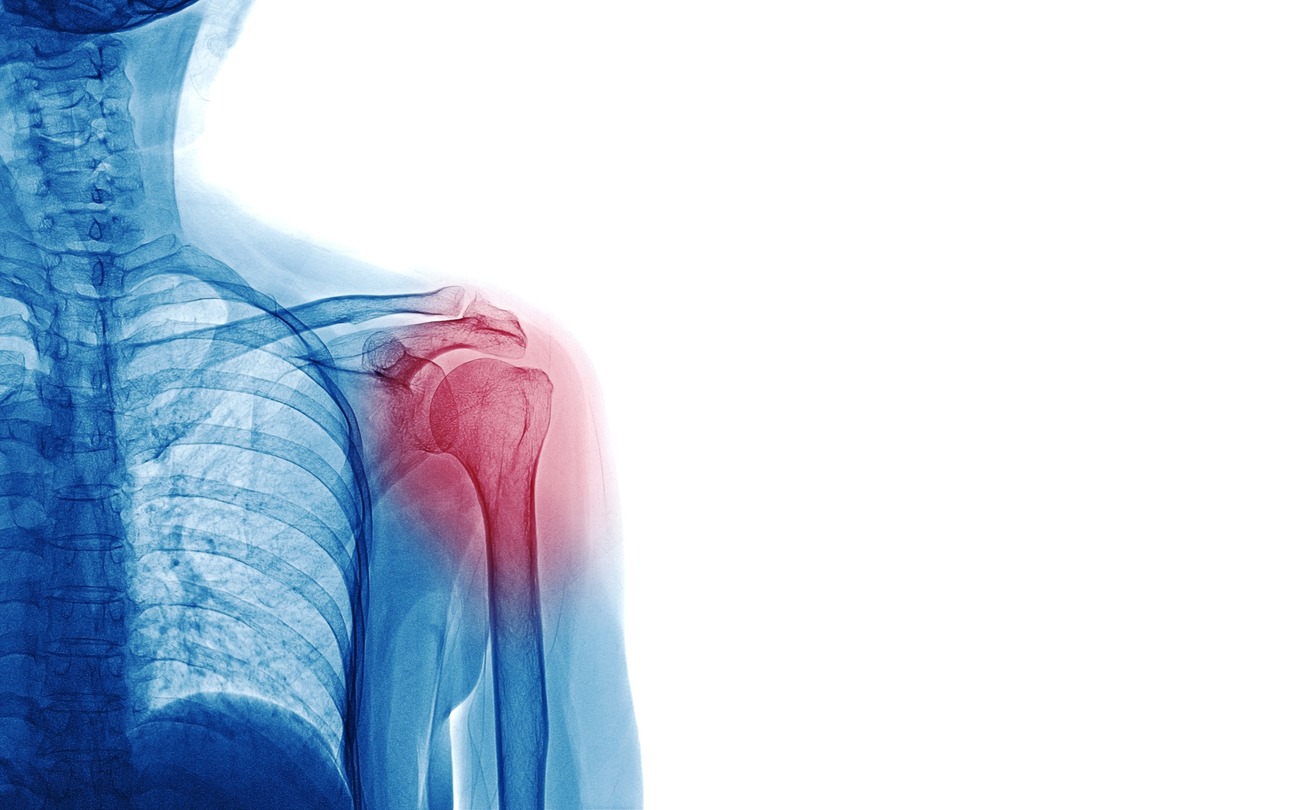If you’re an athlete, chances are you’re relying heavily on your shoulder to play. Whether you hit, throw, swing, lift, or press – the shoulder and its joints always come into play. The shoulder is one of the most complex joints in the body, giving athletes both mobility and stability. However, that’s hard to balance as the more mobile the shoulder joint is, the less stable it is, and vice versa. The extreme stress, repeated movements, and sheer force are often too much for the shoulders to handle.
Athletes may injure their shoulders, which limits arm movement causing aches and discomfort. In this article, learn about the causes of shoulder pains in athletes, how to treat them, and the exercises you can do to relieve shoulder aches and pains.
General Treatments for Shoulder Aches and Pains
Treatments for any shoulder pain or injury may vary, but generally, these are the recommended treatments for almost any shoulder condition:
1. Rest
Typically, the initial approach for treating shoulder pain involves rest. It may require modifying one’s activities for a few days to prevent further strain on the joint and worsening of the symptoms. Of course, it involves avoidance of the activity that caused the pain in the first place. The resting period allows the body to repair the tears and recover from strain, giving you a chance to go back and be your normal self again.
2. Ice
Icing the shoulder using a cold pack is a good way to decrease inflammation and reduce pain. Ice shouldn’t be left in direct contact with the skin for more than five minutes due to the possibility of frostbite.
3. Medication
Over-the-counter pain relievers, such as naproxen and ibuprofen, can help reduce pain and swelling. Acetaminophen can provide pain relief. Sometimes, doctors recommend these meds to reduce pain and inflammation. Also doctors can also prescribe medications and inject steroids or numbing medicine directly into the shoulder to relieve pain.
4. Stretching and exercise
After the resting period, gentle stretching and exercising the shoulder can help people get back to their everyday activities as soon as possible after getting a shoulder injury. Improving flexibility and maintaining the shoulder’s natural motion is essential to prevent further injuries.
5. Physical therapy
Physical therapy can help improve range of motion, strength, and flexibility in the shoulder. A physical therapist can develop an individualized exercise program to help reduce pain and improve function.
6. Slings
Slings help manage shoulder fractures, dislocations, and separations – it keeps the structures of the joint in position. Before using a sling, a doctor will put the bones back in place.
7. Surgery
Some injuries, especially those that are severe, require surgery for treatment, as some do not always improve with rest and medicine.
Causes of Shoulder Pain
Shoulder pain can develop from problems on any part of the shoulder. Diagnosing the cause and type of shoulder problem is important so you can apply proper treatment. Here are some of the causes of shoulder pain:
Rotator cuff injury
The rotator cuff is made of muscles and tendons that act to stabilize the shoulder. It holds the head of the upper arm bone (humerus) in the shoulder blade socket. An injury to the rotator cuff involves damage to one or more of the tendons. It can range from mild to severe and can be caused by overuse or repetitive strain.
Symptoms of a rotator cuff injury can include pain in the shoulder that worsens with movement, weakness or difficulty lifting the arm, and a popping or cracking sensation in the shoulders when moving the arms. When severe, rotator cuff tendon tears can impair the use of the shoulder, limiting day-to-day activities.
Treatment for a rotator cuff injury may include rest, ice, physical therapy, and in more severe cases, surgery. Early diagnosis and treatment can help prevent further damage and improve the condition.
Tendinitis
Tendinitis is inflammation of the tendon, which are thick cords that connect the muscles and bones. Tendinitis is most common in the shoulder, elbow, wrist, knee, and ankle, but it can occur in any tendon in the body. In the shoulder, tendinitis usually affects the tendons of the rotator cuff and those that connect the shoulder blades to the bicep. Tendinitis of the shoulder can cause pain around the shoulder joint and swollen and flushed skin around the affected area.
Symptoms of tendinitis may include pain, swelling, stiffness, and a limited range of motion in the affected area. The pain may be dull or sharp and worsen with movement or activity.
The first step to treating tendinitis is resting the joint. Applying an ice pack to the area for 20 minutes several times daily can help reduce pain and swelling. Taking OTC non-steroidal anti-inflammatory drugs can also help reduce pain and swelling.
In some cases, a corticosteroid injection may be recommended to help reduce inflammation and pain. When tendonitis is severe, surgery may be necessary.
Bursitis
Bursitis is a painful condition referring to the inflammation of a bursa, a small fluid-filled sac that helps cushion and lubricate joints. Bursitis is most common in the shoulder, elbow, hip, knee, and ankle, but it can occur in any joint in the body. It typically results from overuse, injuries, and repetitive movements of the joints.
Bursitis symptoms may include pain, swelling, stiffness, and a limited range of motion in the affected joint. The pain may be dull or sharp and may worsen with movement or activity. Bursitis in the shoulder can cause tenderness and pain, which restricts the movement of the arm and make daily activities hard to do.
Treatment for bursitis often starts by resting, then applying ice packs and taking over-the-counter painkillers like ibuprofen, aspirin, and naproxen. For people with severe bursitis, steroid injections or undergoing a procedure to remove the fluid from the bursae may be necessary. If an infection causes bursitis, a doctor may prescribe antibiotics. In rare cases, surgery may be required to remove the affected bursae.
Tendon tear
A tendon tear, also known as a tendon rupture, is a condition where the tendon tissue is partially or completely torn. Tendons are tough, fibrous tissues that connect muscles to bones and help to facilitate movement. Tendon tears can occur in any part of the body where tendons are present, but they are most common in the shoulders, elbows, knees, and ankles.
Persistent overuse, injuries, or general wear and tear may cause a tendon tear. In the shoulder, tendon tears usually affect the tendons in the biceps and rotator cuffs.
Symptoms of tendon tears include pain, swelling, weakness, and overall reduced mobility in the arm.
The treatment for a tendon tear depends on the severity and location of the tear. In mild cases, rest, ice, and physical therapy may be recommended to help reduce pain and inflammation. Surgery may be necessary to repair or replace the torn tendon in more severe cases. After surgery, physical therapy is often required to help restore strength and function to the affected area.
Shoulder impingement
Shoulder impingement occurs when the tendons and bursae in the shoulder become compressed between the head of the humerus (upper arm bone) and the acromion (a bony projection of the shoulder blade).
People get impingements due to overuse, injury, poor posture, or repetitive motions. This compression can cause pain, inflammation, weakness in the arm, and limited mobility in the shoulder. The pain may be dull or sharp and may worsen with movement or activity. It can also lead to bursitis and tendinitis.
To treat shoulder impingement, one must rest the shoulder, take NSAIDs, and try physical therapy. However, it may take several weeks or months before the symptoms improve. If it doesn’t respond to the treatments at all, a doctor may recommend steroid injections or surgery.
Biceps tendinopathy
Biceps tendinopathy is a condition in which the biceps tendon attaches the biceps muscle to the bone in the shoulder or elbow and becomes damaged or inflamed. This can cause pain, weakness, and limited mobility in the affected joint.
A variety of factors, including overuse, repetitive motions, and injury, can cause biceps tendinopathy. Symptoms may include pain, tenderness, swelling, and weakness in the affected area. The pain in the front of the shoulder becomes worse when reaching overhead, lifting, or carrying objects.
Treatment options for biceps tendinopathy depend on the severity of the condition. Rest, ice, and physical therapy may be recommended in mild cases to help reduce pain and inflammation and improve mobility. Anti-inflammatory medications and corticosteroid injections may also be used to help relieve pain and inflammation.
In more severe cases, surgery may be necessary to repair or remove the damaged portion of the tendon. After surgery, physical therapy is often required to help restore strength and function to the affected area.
Shoulder fracture
A shoulder fracture is a break or cracks in one or more of the bones in the shoulder. It can happen in any of the three bones: the clavicle (collarbone), the scapula (shoulder blade), and the humerus (upper arm bone). Symptoms of a fracture may include swelling, bruising, difficulty moving the arm, and extreme pain.
A shoulder fracture needs rest, ice, and pain medications in mild cases. The arm must also be immobilized by using a sling or brace to help promote healing.
In more severe cases, surgery may be necessary to repair or replace the damaged bone or bones. After surgery, physical therapy is often required to help restore strength and function to the affected arm.
Shoulder dislocation
Shoulder dislocation is a condition in which the upper arm bone (humerus) comes out of the shoulder socket. The shoulder joint is a ball-and-socket joint, and dislocation occurs when the ball (the head of the humerus) is forced out of the socket (the glenoid). It’s usually very painful and usually prevents movement of the affected arm. The shoulder may also appear misshapen or have a bulge under the skin where the bone has come out of place.
Dislocation usually happens due to an injury from playing sports. This condition is an emergency – once you suspect that they have dislocated their shoulder, they should immediately go to the emergency room. You must never try to pop the shoulder back into place, as it may damage the joints or the surrounding tissues.
Once a medical professional has relocated the bone back to the socket, a dislocated shoulder may take several months to fully heal. The shoulder must be rested, and the patient must take NSAIDs and engage in physical therapy to strengthen the shoulder muscles.
Shoulder separation
Also known as acromioclavicular (AC) joint separation, shoulder separation is a condition in which the collarbone (clavicle) separates from the shoulder blade (scapula) at the AC joint. Symptoms may include pain, swelling, tenderness in the front shoulder, and shoulder deformity.
For mild shoulder separations, the first course of action is to take pain medication and use ice to alleviate immediate symptoms. A sling is typically worn for a period of seven to ten days to provide support while the joint recovers. X-rays are usually performed to determine the extent of collarbone displacement, and an MRI may be ordered if there are concerns about damage to other areas of the shoulder. Patients who have sustained only minor damage may be able to resume their regular activities within one to two weeks after the injury, although complete recovery may take longer.
In more severe cases, surgery may be necessary to repair or reconstruct the damaged ligaments. After surgery, physical therapy is often required to help restore strength and function to the affected shoulder.
Exercises to Relieve Shoulder Aches and Pain
Exercises, including yoga poses and gentle stretches, can help strengthen your muscles and relieve pain. Tightness and shoulder pain is common, but you can always take steps to relieve discomfort. Here are some of the exercises and poses to alleviate shoulder aches and pains:
Across-the-chest stretch
This exercise helps stretch the shoulders and upper back muscles, increasing flexibility and range of motion in the shoulder joint and surrounding muscles. To perform this stretch:
1. Stand up straight with your feet shoulder-width apart.
2. Reach your right arm across your chest, placing your left hand on your right elbow to gently pull your arm closer to your chest.
3. Hold the stretch for 15-30 seconds, feeling the stretch in the back of your shoulder and upper arm.
4. Release the stretch and repeat on the other side, reaching your left arm across your chest and placing your right hand on your left elbow.
5. To deepen the stretch, lift your arm to shoulder height. But if you’re feeling any pain in the shoulder, lower your arm.
Neck release
The neck release stretch is a simple stretch that helps to relieve tension in the neck, shoulders, and upper back. To perform this stretch:
1. Sit or stand up straight with your shoulders relaxed.
2. Tilt your head to the right, bringing your right ear towards your right shoulder.
3. Place your right hand over the top of your head and gently apply pressure to deepen the stretch.
4. Hold the stretch for 15-30 seconds, feeling the stretch on the left side of your neck and shoulder.
5. Release the stretch and repeat on the other side, tilting your head to the left and placing your left hand over the top of your head.
Chest expansion
This exercise helps stretch the chest, shoulders, and upper back muscles. It promotes flexibility and range of motion in the shoulders. To perform this stretch:
1. Sit or stand up straight with your shoulders relaxed.
2. Interlace your fingers behind your back, with your palms facing inward.
3. Slowly lift your arms up and away from your body, keeping your shoulders relaxed and your chest lifted.
4. Hold the stretch for 15-30 seconds, feeling the stretch in your chest and shoulders.
5. Release the stretch and repeat as desired.
Eagle arms spinal rolls
Eagle arms spinal rolls is a yoga pose that combines the Eagle arms pose with spinal rolls. It helps to stretch and release tension in the shoulders, upper back, and spine. If you’re uncomfortable with the arm position, do this exercise by holding opposite shoulders. Here’s how to do it:
1. Start by sitting or standing up straight with your shoulders relaxed.
2. Bring your right arm under your left arm and wrap your forearms around each other, bringing your palms to the touch.
3. Lift your elbows up to shoulder height, and draw your shoulder blades down your back.
4. Take a deep breath in, and on the exhale, round your spine forward, dropping your chin to your chest and letting your arms stretch forward.
5. Inhale, and then exhale as you slowly roll your spine back up to a straight position.
6. Release your arms and repeat on the other side, bringing your left arm under your right arm and wrapping your forearms around each other.
Seated twist
The seated twist is a yoga pose that helps to stretch the muscles in the back, hips, and shoulders while also helping to improve digestion and detoxification. Let the twist start in your lower back. To do this stretch:
1. Sit up straight in a chair with your feet flat on the floor.
2. Place your right hand on the outside of your left knee and your left hand on the armrest of the chair.
3. Inhale and lengthen your spine, lifting the crown of your head towards the ceiling.
4. Exhale and twist your torso to the left, using your left hand to gently pull on the armrest of the chair and your right hand to deepen the twist.
5. Hold the stretch for 5-10 deep breaths, feeling the stretch in your back, hips, and shoulders.
6. Inhale and release the twist, then repeat on the other side by placing your left hand on the outside of your right knee and your right hand on the armrest of the chair.
Shoulder circles
This exercise warms up the shoulder joints and increases flexibility. It’s a simple and effective exercise for improving shoulder mobility and reducing tension in the upper body. Here’s how to perform the exercise:
1. Stand up straight with your feet shoulder-width apart and your arms at your sides.
2. Inhale and lift your shoulders up towards your ears, squeezing your shoulder blades together.
3. Exhale and roll your shoulders back and down, pushing your shoulder blades down your back.
4. Inhale and lift your shoulders up towards your ears again.
5. Exhale and roll your shoulders forward and down, letting your shoulder blades slide around your ribcage.
6. Repeat this circular motion for 10-15 repetitions, moving slowly and mindfully with your breath.
7. After completing the shoulder circles in one direction, reverse the direction and repeat the exercise in the opposite direction.
Cat-cow stretch
The cat-cow stretch is a yoga pose that involves moving the spine between two opposing positions, providing a gentle stretch to the back and neck muscles. Here’s how to do it:
1. Start on your hands and knees in a tabletop position, with your wrists under your shoulders and your knees under your hips.
2. Inhale and do the cow pose by lifting your tailbone towards the ceiling, arching your back, and dropping your belly toward the ground.
3. Allow your head to hang naturally without straining your neck.
4. Hold the pose for a few seconds and feel the stretch in your spine and belly.
5. Exhale and do the cat pose by rounding your spine, dropping your head towards the ground, and pulling your belly button in towards your spine.
6. Hold the pose for a few seconds and feel your spine and neck stretch.
7. Repeat the sequence for 5-10 deep breaths, moving slowly and mindfully with your breath.
Child ’s pose
This restorative yoga pose helps relieve the tension in the neck, shoulders, and back. It is often used as a resting pose between more challenging poses. Here’s how to perform it:
1. Start on your hands and knees in a tabletop position, with your wrists under your shoulders and your knees under your hips.
2. Inhale and lengthen your spine, reaching the crown of your head towards the ceiling.
3. Exhale and lower your hips back towards your heels, stretching your arms out in front of you and resting your forehead on the ground.
4. Allow your arms to rest by your sides or stretch them out in front of you, and let your chest fall heavy towards the floor, relaxing the spine and shoulders.
5. Keep your knees together or separate them as much as you need to feel comfortable.
6. Breathe deeply and hold the pose for at least a minute, feeling the stretch in your hips, thighs, and back.
7. To release the pose, inhale and lift your head and torso back up to a tabletop position.
Thread the needle
This yoga pose relieves tightness in the shoulders, chest, and upper back by twisting the spine. You can put a cushion or block under the head or shoulder if you want to support it.
1. Start on your hands and knees, with your wrists under your shoulders and your knees under your hips.
2. Inhale and reach your right arm up towards the ceiling, twisting your spine and looking up towards your right hand.
3. Exhale and thread your right arm underneath your left arm, lowering your right shoulder and ear to the ground.
4. Keep your left hand on the ground and reach your left arm straight out in front of you, stretching your shoulder and upper back.
5. Allow your head to rest on the ground, or lift it slightly to gaze towards your left fingertips.
6. Hold the pose for 30 seconds, feeling the stretch in your shoulders, upper back, and spine.
7. Relax in a child’s pose before repeating the stretch on the other side.
Downward dog
Downward dog is a yoga pose that stretches the muscles in the back, shoulders, hamstrings, and calves while also building strength in the arms, back, and shoulders. Here’s how to perform the pose:
1. Start on your hands and knees, with your wrists directly under your shoulders and your knees directly under your hips.
2. Inhale and tuck your toes under, lifting your hips up towards the ceiling to come into a “V” shape with your body.
3. Straighten your arms and legs as much as possible, pressing your hands and feet into the ground.
4. Lengthen your spine by reaching your tailbone towards the ceiling and pressing your heels down towards the ground.
5. Keep your head and neck relaxed, with your gaze towards your knees or towards your belly button.
6. Hold the pose for a minute, feeling the stretch in your back, shoulders, hamstrings, and calves.
7. To release the pose, exhale and bend your knees, coming back down to your hands and knees.
Conclusion
There are many causes of shoulder aches and pains, and it’s important to know the cause to apply proper treatment. Resting, icing the shoulder, and taking pain medications are the first line of defense against shoulder pain, but in severe cases, steroid injections or surgery is recommended. You can also perform different kinds of stretches and poses before doing sports and strenuous activities to prevent shoulder pains.





